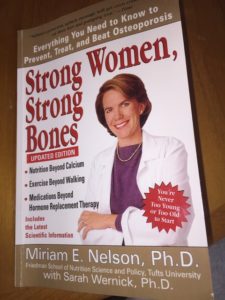Do you think a lot about your bones? In fact, have you ever thought about them? I’ve started to think about mine recently, ever since I started reading Strong Women, Strong Bones*.
I was surprised to learn that we have two different types of bone in our bodies. I always thought all our bones were all the same: hard, solid and not easily broken. Well, the truth is a little more complicated. Some of our bones are like this. They are called Cortical Bone. These are the long bones we can easily feel in our arms and legs. They are difficult to break because they are so dense.
But we have another type of bone also. This one is very different. It looks a lot like the inside of a kitchen sponge. This type of is called Trabecular Bone. These bones have a “porous inner layer, are light and have a lattice structure.”**
Our Trabecular Bone are located at the end of some of our long, solid bones, for example in our wrists. That’s why our wrists are not as strong as our arms and break easier if we fall on them. As we get older, the empty spaces in our Trabecular Bones become larger. This makes them weaker so they can break more easily.
I also learned that our bones are constantly remodeling themselves. That means they are being broken down and rebuilt throughout our lives. The bones we have today are not the ones we were born with or grew up with! They are just the latest version of our ongoing remodeling project.
The cells responsible for tearing down our bones are called osteoclasts and the ones who do the reconstruction are called osteoblasts. They are not in balance. At the beginning of our lives, the osteoblasts are winning because they are building more bone than is being torn down. But, and there is always a but, as we mature and grow older, the osteoclast take the lead because they are tearing down more bone than is being replaced. That is why someone who starts out in life with very strong bones can end up with very fragile and weak ones.
When we’re young, especially until we’re 25, we’re growing bone, much more than is being torn down. In our thirties, most of us are in balance. We’re gaining as much bone as we’re losing. But in our forties, this balance starts to shift and not in a good direction. We begin to lose a little more bone than we’re gaining and after 50 this process speeds up as we lose bone much faster than it is being replaced. This is especially true for women.
This may all sound depressing but don’t give up just yet. Keep reading! There are things we can do to make our bones stronger and so less likely to break. Strong Women, Strong Bones talks about how important eating right is, especially getting enough calcium. It also talks about the importance of Vitamin D, whether you get it from the sun or a pill. Most importantly, it gives exercises we can do to improve our situations.
We can relearn how to stand taller, strengthen our bones and improve our balance. Yes, it does take hard work and setting aside some time each day to work on this. But, if we want to improve our situations, we can.
You may not have thought about your bones before reading this but maybe now is the time to start!
*Strong Women, Strong Bones by Miriam E. Nelson, Ph.D. with Sarah Wernick, Ph.D., A Perigee Book, 2000.
**Strong Women, Strong Bones, Page 18.


2 comments
Interesting blog, Claire. With the many bone issues I’ve had, this book sounds like something I should read. Thanks for the information.
Sounds like a good book to read. Thanks for bringing it to our blog.